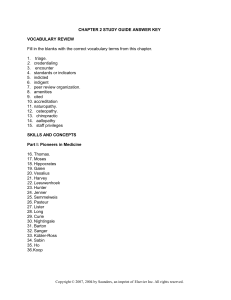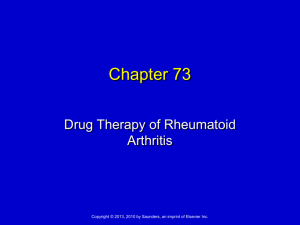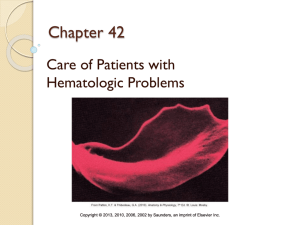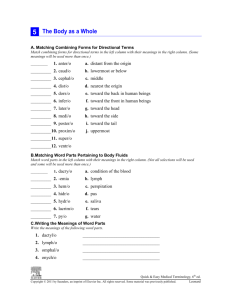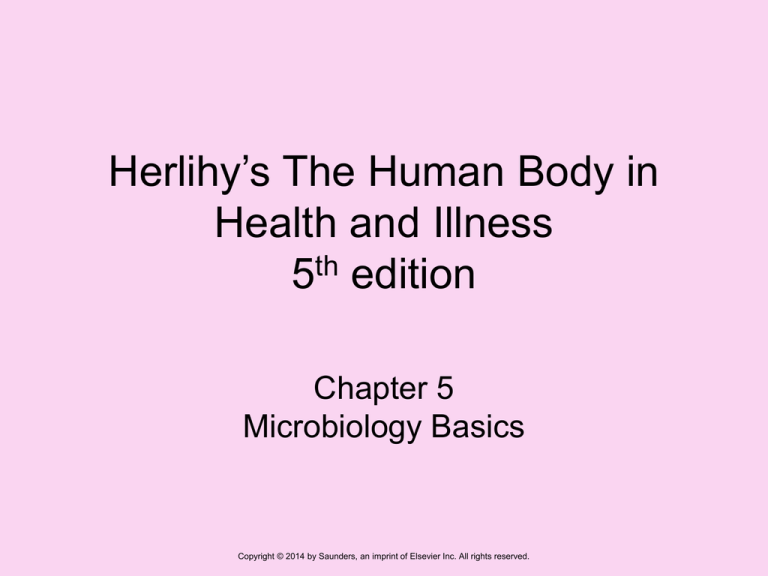
Herlihy’s The Human Body in
Health and Illness
5th edition
Chapter 5
Microbiology Basics
Copyright © 2014 by Saunders, an imprint of Elsevier Inc. All rights reserved.
Lesson 5.1
Microbiology Basics
1. Define disease and infection.
2. List the characteristics of the different types of
pathogens, including the types of bacteria by shape.
3. Describe the types of bacteria by staining
characteristics.
4. Define portals of exit and portals of entry.
5. List common ways by which infections are spread.
6. Identify the microbiological principles described in
Five Germ-Laden Stories.
Copyright © 2014 by Saunders, an imprint of Elsevier Inc. All rights reserved.
2
What Is Disease?
Disease: Failure of the body to function
normally
Pathogens: Disease-producing
microorganisms
Infection: Invasion of the body by a pathogen
Localized: Restricted to a small area
Systemic: More widespread; usually spread
through blood
Copyright © 2014 by Saunders, an imprint of Elsevier Inc. All rights reserved.
3
Microorganisms and Multicellular
Pathogens
Bacteria
Viruses
Fungi
Protozoa
Worms
Arthropods
Copyright © 2014 by Saunders, an imprint of Elsevier Inc. All rights reserved.
4
Looking at Bacteria
Single cell
Have cell wall
Able to form spores
Often grouped by shapes, clusters
Coccus (round), bacillus (rod-shaped), curved rod
Copyright © 2014 by Saunders, an imprint of Elsevier Inc. All rights reserved.
5
Viruses, Fungi, Protozoa: SingleCelled Organisms
Virus consists of DNA or RNA with a protein
shell
Viruses reproduce only within a host
Fungi cause mycotic infections
Protozoa are animal-like microbes
Copyright © 2014 by Saunders, an imprint of Elsevier Inc. All rights reserved.
6
Arthropods and Worms:
Multicellular Organisms
Worms
Round or flat
Transmission by fecal-oral route
Arthropods
Animals with jointed legs
Ectoparasites and vectors
Copyright © 2014 by Saunders, an imprint of Elsevier Inc. All rights reserved.
7
Identifying Bacteria in the Lab
Staining
Gram stain
• Gram-positive (purple or blue)
• Gram-negative (pink or red)
Acid-fast stain (retains red stain)
Culture: Pathogen sample collected and
grown in a medium
Copyright © 2014 by Saunders, an imprint of Elsevier Inc. All rights reserved.
8
CHAIN OF INFECTION
Copyright © 2014 by Saunders, an imprint of Elsevier Inc. All rights reserved.
9
The Spread of Infection: Portals
of Entry
Respiratory tract
Gastrointestinal tract
Genitourinary tract
Eyes
Skin
Parenteral route
Copyright © 2014 by Saunders, an imprint of Elsevier Inc. All rights reserved.
10
The Spread of Infection: Portals
of Exit
Respiratory tract
Gastrointestinal tract
Genitourinary tract
Eyes
Skin
Breasts
Copyright © 2014 by Saunders, an imprint of Elsevier Inc. All rights reserved.
11
The Spread of Infection: Modes
of Transmission
Modes of transmission
Person-to-person
Environment-to-person
Tiny animals–to-person
Copyright © 2014 by Saunders, an imprint of Elsevier Inc. All rights reserved.
12
Dr. Semmelweis Screams,
“Wash Those Mitts!”
Read the story of Dr. Semmelweis
What does the story tell us about nosocomial
infection?
Identify current parallels:
H1N1 flu
MRSA
Copyright © 2014 by Saunders, an imprint of Elsevier Inc. All rights reserved.
13
Flora and Her Vaginal Itch
Read Flora’s story
What does this story tell us about normal
flora, antibiotics, and superinfection?
Copyright © 2014 by Saunders, an imprint of Elsevier Inc. All rights reserved.
14
Rick, Nick, and the Sick Tick
Read the story of the sick tick
What does the story tell us about animal
vector, reservoir of infection, and zoonosis?
How does the story illustrate the difference
between a communicable disease and a
contagious disease?
Copyright © 2014 by Saunders, an imprint of Elsevier Inc. All rights reserved.
15
Why Typhoid Mary Needed to
Lose Her Gallbladder
Read Mary’s story
How does this famous historical event
illustrate the concepts of carriers and
reservoirs of infection?
Copyright © 2014 by Saunders, an imprint of Elsevier Inc. All rights reserved.
16
A Pox News Alert
Read the account of the various uses of the
term pox
Describe the range of conditions described as
poxes, and identify the most important
contemporary and historical examples
Copyright © 2014 by Saunders, an imprint of Elsevier Inc. All rights reserved.
17
Dr. Herbie Zoster
Herpes zoster is shingles, a painful infection
of the peripheral nervous system
Caused by the varicella-zoster virus, which
also causes chickenpox
Copyright © 2014 by Saunders, an imprint of Elsevier Inc. All rights reserved.
18
Questions?
Copyright © 2014 by Saunders, an imprint of Elsevier Inc. All rights reserved.
19





